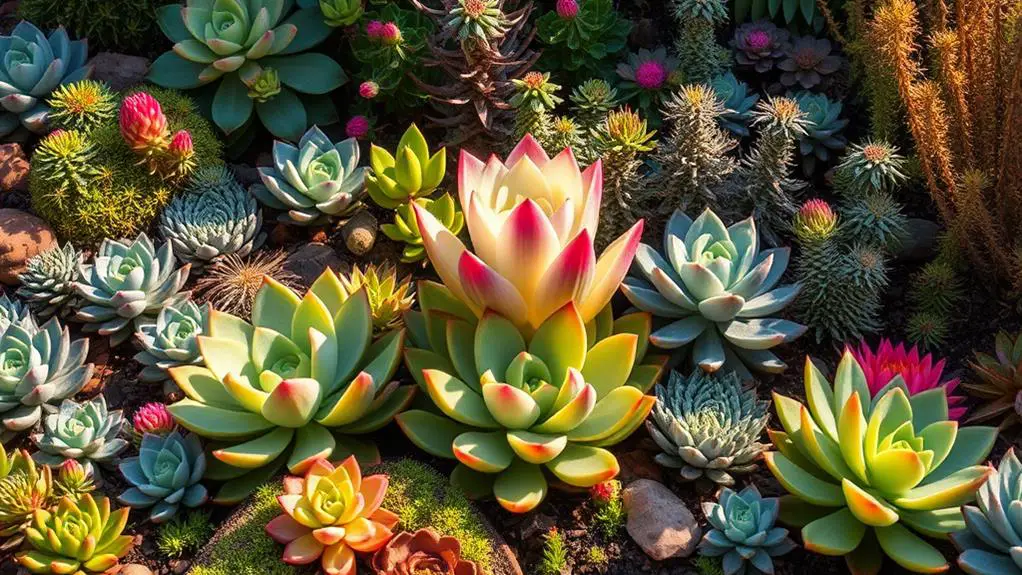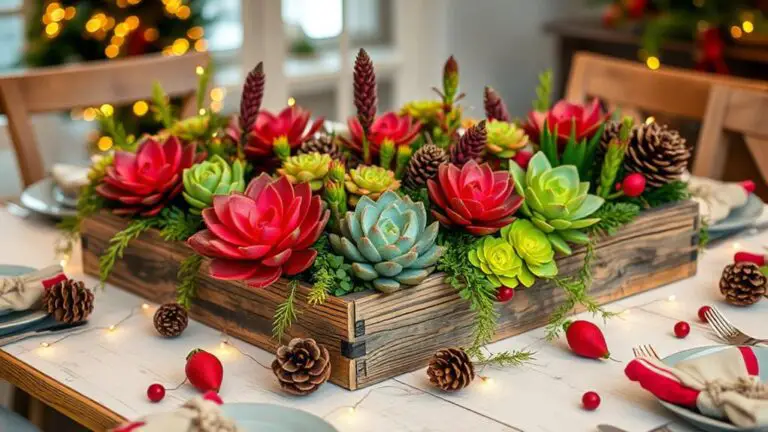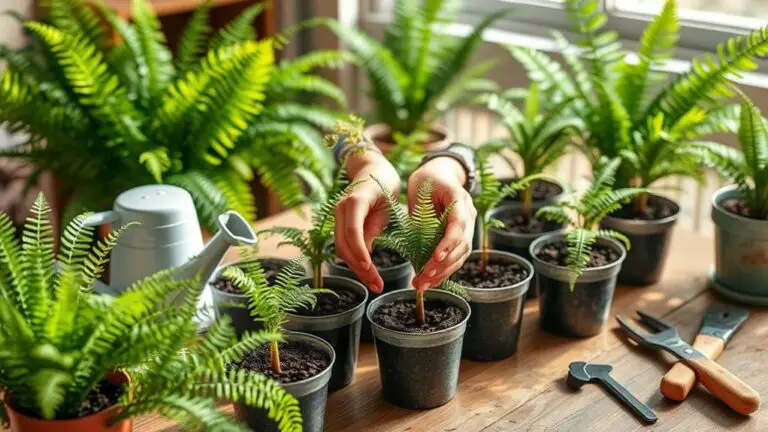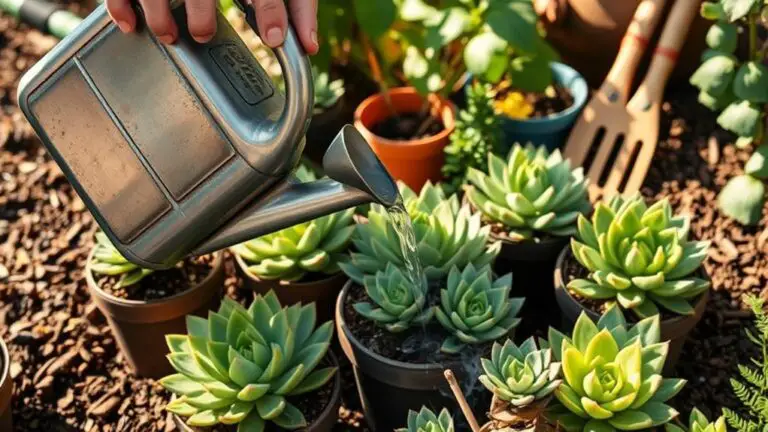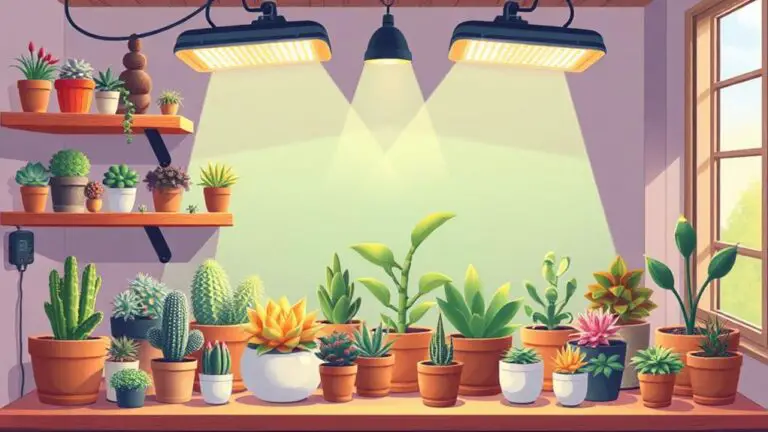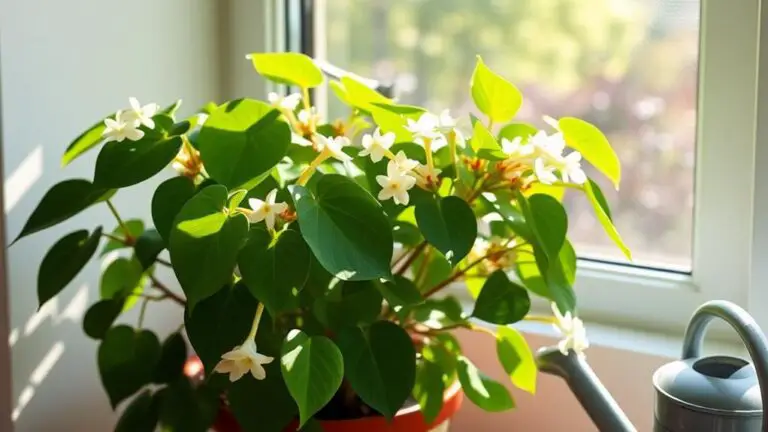Understanding Monocarpic Succulents – A Comprehensive Guide
When you start exploring monocarpic succulents, you'll find their unique lifecycle both intriguing and somewhat poignant. These plants, including Agave and Sempervivum, bloom gloriously just once before they die, leaving behind offsets to continue their legacy. Understanding why they follow this rare reproductive strategy and how to care for them through their life stages can deepen your appreciation for these resilient species. But what exactly triggers their single flowering event, and how can you guarantee they thrive until that moment? Let's explore the intricacies of these engaging plants.
Definition and Characteristics
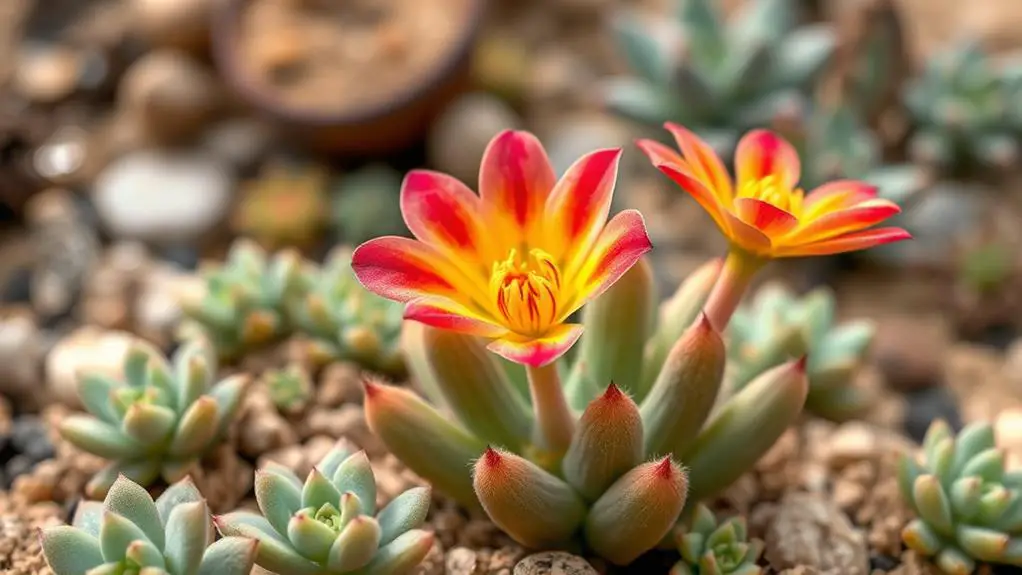
Monocarpic succulents include popular varieties like Agave, Sempervivum, Kalanchoe, and certain Aeonium species.
Before they bloom, these plants often produce offsets, also known as "pups." These small plants grow around the base of the parent succulent. Offsets allow the plant to reproduce vegetatively, ensuring its survival even after the main plant dies.
The flowering process is a natural part of a monocarpic succulent's lifecycle. Once they bloom, they generally lack the energy to sustain life, leading to their eventual decline and death, no matter how well you care for them.
Understanding this can help you appreciate the beauty and resilience of these fascinating plants. So, don't be disheartened when your monocarpic succulent blooms and dies; remember, it's just part of nature's incredible cycle.
Types of Monocarpic Succulents

Now, let's talk about some popular monocarpic succulents and their unique bloom characteristics.
Agave species can live for up to 25 years before producing a spectacular bloom, while Sempervivum, or Hens and Chicks, create multiple offsets before flowering and dying after 3-4 years.
You'll also find Aeonium with its rosette form, and the stunning blooms of certain Echeveria and Kalanchoe species, all showcasing their beauty before the parent plant ends its life cycle.
Popular Monocarpic Varieties
When exploring the fascinating world of monocarpic succulents, you'll encounter some truly remarkable varieties that stand out for their unique life cycles and stunning appearances. These plants live to flower just once before they die, leaving behind offsets to continue their legacy. Let's immerse ourselves in some popular monocarpic succulents that you might want to add to your collection.
Echeveria species like Echeveria Afterglow are especially popular. They produce beautiful, vibrant flowers before their life cycle ends. Despite their eventual death, these succulents leave behind offsets for new growth. Agave varieties can take up to 25 years to bloom, making their flowering event a long-anticipated spectacle. Once they flower, they also produce offsets before dying.
Sempervivum, commonly known as Hens and Chicks, bloom within 3 to 4 years and produce numerous offsets, ensuring your garden never lacks these charming plants. Kalanchoe species, such as Kalanchoe luciae, are known for their thick leaves and dramatic blooms that also signal the end of their life cycle. Finally, Aeonium species feature a mix of monocarpic and non-monocarpic varieties, with the former producing offsets after their single flowering event.
| Succulent | Bloom Time | Unique Feature |
|---|---|---|
| Echeveria | Varies | Stunning flowers, popular |
| Agave | Up to 25 years | Long wait, large bloom |
| Sempervivum | 3-4 years | Numerous offsets, hens and chicks |
| Kalanchoe | Varies | Thick leaves, dramatic blooms |
| Aeonium | Varies | Mix of life cycles, offsets |
These monocarpic succulents are not only beautiful but offer a fascinating glimpse into the plant world's unique cycles.
Unique Bloom Characteristics**
As you explore the unique bloom characteristics of monocarpic succulents, you'll notice their final flowering phase often transforms the plant's appearance dramatically. Monocarpic succulents like Agave and Sempervivum typically produce a single, large flower stalk as their final reproductive effort before they die, often called "death blooms." This flowering phase marks a significant change, with many species forming a rosette that supports the emergence of their impressive blooms.
For instance, Kalanchoe species, such as the Paddle Plant, have thick, overlapping leaves and produce vibrant flowers. These blooms signal the start of their monocarpic lifecycle.
Aeonium succulents also display monocarpic behavior, blooming after several years. They often produce offsets, or new plantlets, even as they prepare for their singular flowering event.
When these succulents bloom, their death blooms can showcase a variety of colors, especially pink and orange. These bright hues attract pollinators, which are essential for seed production.
Understanding these unique bloom characteristics will help you appreciate the lifecycle of monocarpic succulents and guide you in caring for them during their final, beautiful flowering phase.
Post-Bloom Death Reasons
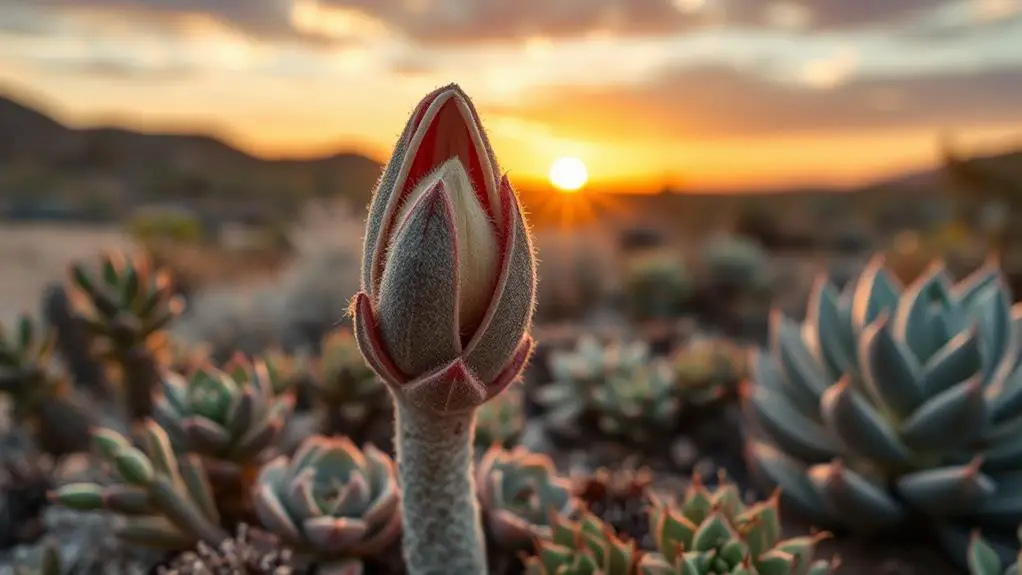
Monocarpic succulents, such as Sempervivum and Agave, die post-bloom because they deplete their energy reserves during the flowering process, leaving them unable to sustain life afterward.
During the flowering phase, these plants pour all their energy into producing flowers. This intense effort is part of their natural life cycle. By the end, the parent plant has used up most of its energy reserves, leading to its inevitable post-bloom death.
You might wonder why this happens. After flowering, the plant has completed its reproductive goal. The parent plant's death isn't due to external care factors like soil or watering conditions. It's just a natural part of being monocarpic.
Many monocarpic succulents may take years to bloom, but once they do, they typically die within weeks to months.
But don't worry, this isn't the end of your succulent garden. These plants often produce seeds or offsets before they die.
These new plants can grow into healthy succulents, continuing the species. So, while the parent plant's life ends, it's really making way for new plants to thrive.
Understanding this cycle helps you appreciate the full beauty and resilience of monocarpic succulents.
Flowering Characteristics
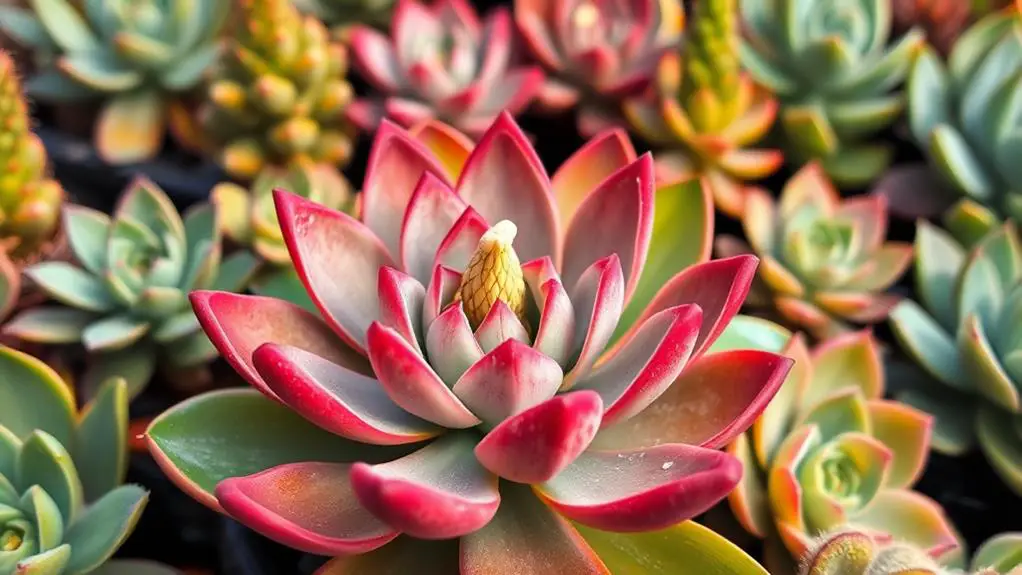
Understanding why monocarpic succulents die post-bloom can enhance your appreciation of their flowering characteristics. When a monocarpic plant flowers, it's a once-in-a-lifetime event that marks the plant's final reproductive effort before death. This unique trait makes their blooms all the more special.
The flowering characteristics of monocarpic succulents vary widely. For instance, Agave plants can produce tall flower spikes that reach up to 8 feet, creating a striking visual in your garden. On the other hand, Sempervivum succulents have smaller, rosette-centered blooms that are equally enchanting but more modest in size.
Many monocarpic succulents, such as Kalanchoe, boast dramatic and vibrant flower colors like pink and orange, which attract pollinators. These colors aren't just beautiful; they play an essential role in the plant's reproductive process.
The flowering phase is often triggered by environmental factors like maturity, seasonal changes, and stress. This indicates that the plant has reached its reproductive age.
After flowering, most monocarpic succulents produce seeds and, in some cases, offsets or pups. These new plants guarantee the continuation of the species, even after the parent plant's death.
Understanding these characteristics allows you to appreciate the full lifecycle of these fascinating plants.
Care for Flowering Succulents
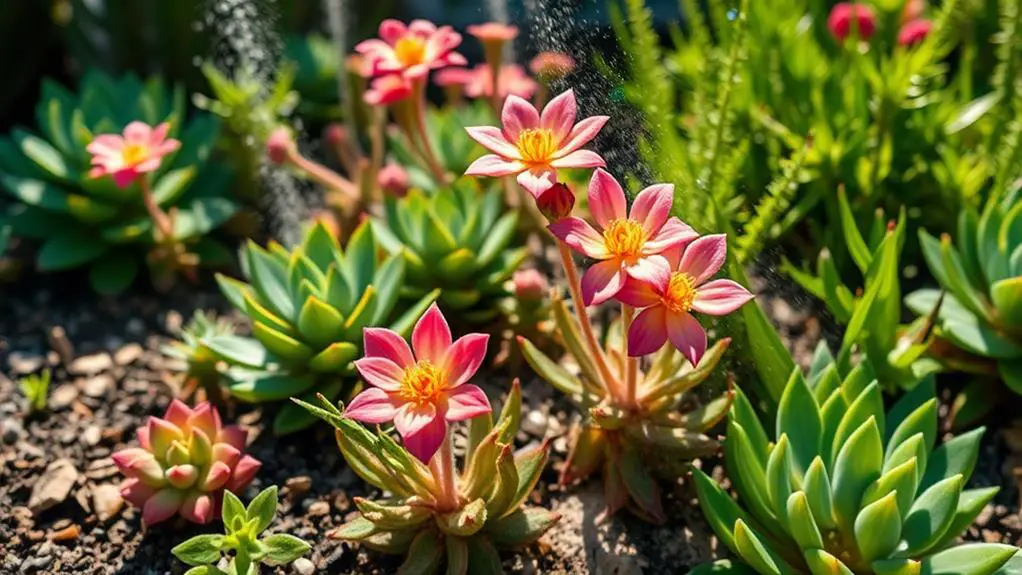
Caring for flowering succulents involves a few key practices to guarantee they thrive and produce their stunning blooms.
First, providing adequate sunlight is vital. Most succulents need several hours of direct light daily to bloom successfully. Place them near a sunny window or in a spot where they receive plenty of sunlight.
Next, focus on the soil. Growing succulents in well-draining, nutrient-rich soil is fundamental. This type of soil prevents root rot and supports healthy growth. You can find special succulent soil mixes at garden centers that work perfectly.
Seasonal adjustments in watering practices are also important. During their active growing season, succulents typically need more water. However, during dormancy, reduce watering to prevent over-saturation. Always monitor the soil's moisture level before watering again.
Keep an eye on environmental conditions like temperature and humidity. These factors can greatly impact the flowering process and overall health of your succulents. Stable, moderate temperatures are ideal.
Lastly, prune dead flower stalks promptly after blooming. This helps redirect the plant's energy towards seed development and keeps it tidy.
Popular Succulent Varieties
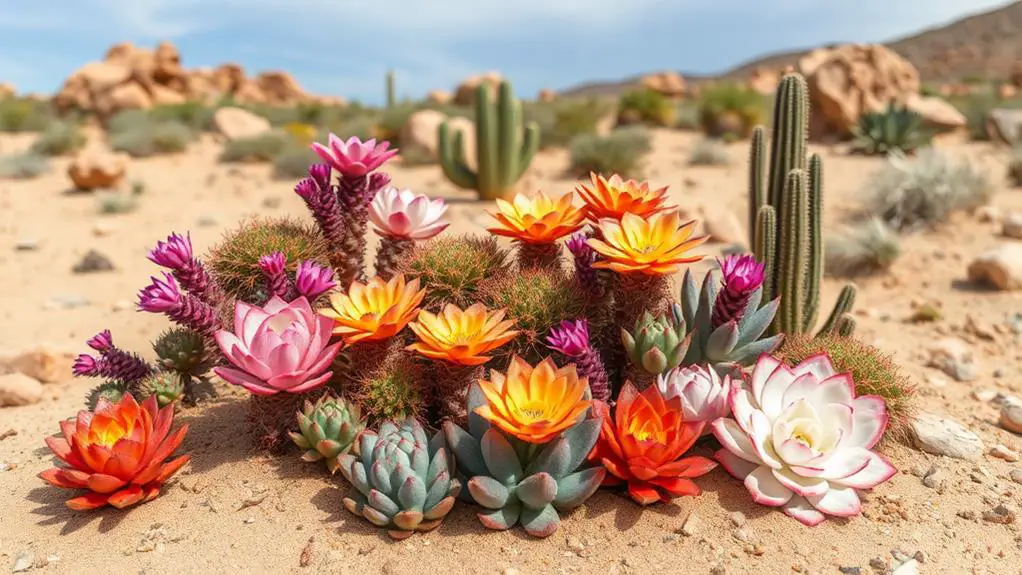
Exploring popular succulent varieties offers a fascinating glimpse into the diverse world of these resilient plants. Among these, Agave is a standout. This monocarpic plant can take decades to bloom, producing a tall flower spike before the parent plant dies. Its dramatic flowering event is worth the wait.
Next, you have Sempervivum, or Hens and Chicks. These succulents bloom in about 3 to 4 years and produce multiple offsets before dying. They're great for beginners since they're easy to propagate.
Kalanchoe luciae, also known as the Paddle Plant, catches your eye with its thick, paddle-shaped leaves. It's another monocarpic succulent, with a striking flowering event that marks the end of the parent plant's life.
Aeonium species are known for their rosette growth form and can also be monocarpic. They bloom dramatically after several years, making them a rewarding addition to your collection.
Lastly, Echeveria varieties, while not all monocarpic, include stunning species like Afterglow. These can produce beautiful blooms before the plant's life cycle ends.
Understanding these popular varieties helps you appreciate the unique life cycles and beauty of monocarpic succulents. Enjoy your gardening journey!
Largest Succulent Species
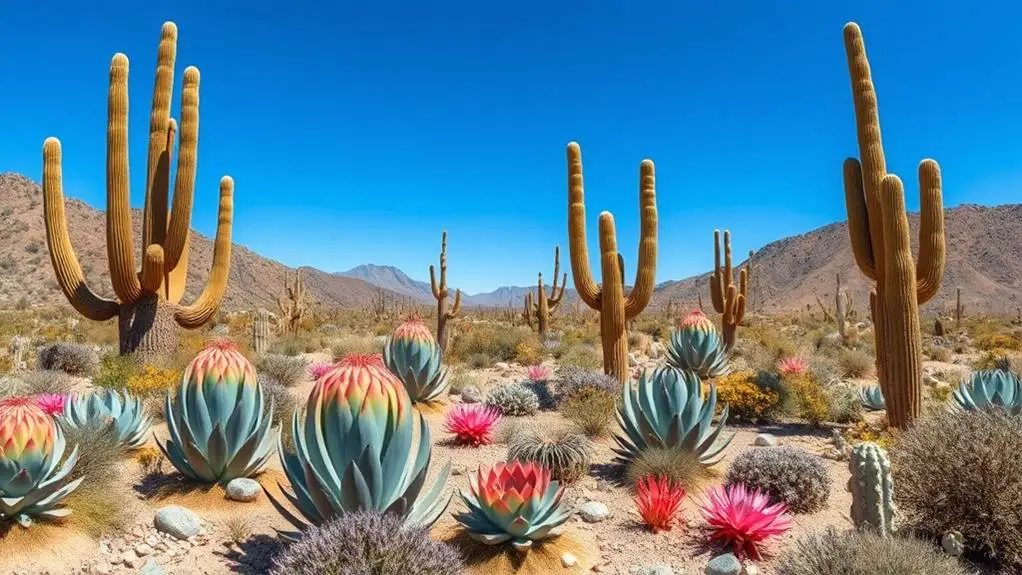
After appreciating the unique life cycles and beauty of monocarpic succulents, let's look at the largest succulent species that captivates with its grandeur.
The African baobab (Adansonia digitata) stands out not only because of its immense size but also due to its fascinating adaptations. These succulent plants can grow trunks up to 36 feet in diameter and reach heights of 80 feet. Even though baobabs aren't monocarpic, they provide an excellent example of succulents that live a long life, sometimes over a thousand years.
Baobabs are true survivors, thriving in arid environments by storing water in their massive trunks. This adaptation allows them to endure prolonged drought periods.
The blooming succulent aspect of baobabs is equally intriguing. They produce large, white flowers that open at night and are pollinated by nocturnal creatures like bats.
While baobabs don't follow the monocarpic pattern of blooming once and then producing progeny, their ability to thrive in harsh conditions showcases the incredible diversity among succulent species.
Propagation and Care Strategies
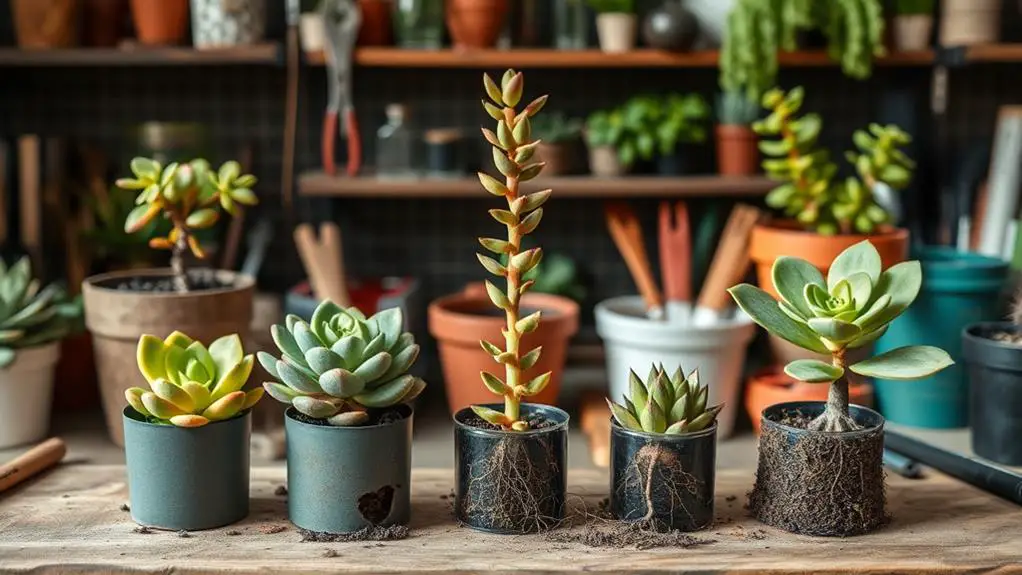
When propagating monocarpic succulents, you'll want to harvest offsets or pups before the main plant dies, ensuring its lineage continues.
Make sure to separate the pups once they're one-third the size of the mother plant for healthy growth.
After the plant blooms, prune dead flower stalks to help the remaining parts stay tidy and use their energy efficiently.
Harvesting Offsets Effectively
To guarantee successful propagation of monocarpic succulents, it's crucial to harvest offsets or pups before the parent plant flowers. This guarantees the plant's lineage continues, as many monocarpic succulents produce these clones before their death bloom.
Start by using clean, sharp tools to detach pups from the mother plant. Make sure to leave a small portion of the base attached to encourage healthy growth.
Once you've harvested the offsets, allow them to dry for a few hours to a couple of days. This step helps prevent rot by letting any cuts callous over.
After drying, plant the offsets in well-draining soil. Initially, water sparingly, as the young plants need time to establish roots before they can handle a regular watering schedule.
Keep a close eye on the new plants for signs of stress or disease. Confirming they receive adequate light and proper care will help them thrive after separation.
Regular checks will help you catch and address any issues early, promoting strong, healthy growth in your succulent garden.
Seed Propagation Tips
Propagating monocarpic succulents from seeds can be a rewarding but patient endeavor. When the plant is monocarpic and has finished its bloom, it's time to collect mature seeds. Make sure these seeds come from a healthy bloom to boost germination chances.
Start by sowing the seeds in a well-draining soil mix. Lightly cover them since most succulent seeds need light to germinate. Create a warm, humid environment to encourage sprouting. This means you might need to use a humidity dome or a plastic cover.
Monitor moisture levels closely. Water the soil minimally to prevent damping off, which is a fungal issue that can harm young seedlings. Place the tray in an area with indirect sunlight to help them grow strong.
Be patient because seed propagation can take several weeks to months or even years, depending on the species. Once the seedlings develop a few true leaves, transplant them carefully into individual pots. This prevents overcrowding and gives them room to produce offsets or pups in the future.
Throughout this process, continue to provide excellent care. With time and dedication, you'll see your monocarpic succulents thrive.
Post-Bloom Plant Maintenance
After successfully collecting seeds and tending to young seedlings, it's time to focus on post-bloom plant maintenance to confirm the continued vigor of your monocarpic succulents.
When your monocarpic succulent flowers and starts to die, promptly harvest offsets, or pups, before the plant's energy is entirely depleted. This step is essential to preserve its lineage.
Monitoring the mother plant for signs of decline, like discoloration or leaf drop, will help you determine the right time for harvesting pups and seeds.
While the parent plant is still alive, make sure it gets adequate light and water to support its final reproductive effort.
Once the plant dies and dries out, you can replant the harvested pups in separate pots. This gives them the best chance to grow as independent plants.
Seeds collected post-bloom will need specific conditions for germination, so research the particular species' needs for successful propagation.
This post-bloom maintenance isn't just about keeping new plants thriving; it's also about understanding and respecting the life cycle of your monocarpic succulent.
With careful monitoring and timely action, you'll confirm the continued health and beauty of your garden.
Frequently Asked Questions
How to Tell if a Succulent Is Monocarpic?
To tell if a succulent is monocarpic, look for a large flower spike at maturity, a rosette form, and the production of offsets before blooming. These signs mean the plant will die after flowering, ensuring its lineage continues.
Should I Cut the Flower Stem off My Succulent?
Yes, you should cut the flower stem off your succulent. Wait until the stem dries out completely. This redirects energy to the offsets, prevents rot, and enhances the plant's appearance. Be careful not to damage the main rosette.
Should I Cut off a Death Bloom?
Yes, you should cut off a death bloom. Doing so promotes tidiness and redirects energy back to the plant. Wait until it's completely dry, then use clean, sharp tools. Continue regular care to support recovery.
What Is a Death Bloom in Succulents?
A death bloom in succulents is when the plant flowers once and then dies. It's a natural process where the plant uses all its energy to produce seeds or offsets, ensuring the species' survival.
Conclusion
With this guide, you'll confidently care for monocarpic succulents. Remember, they bloom once and then die, but their offsets guarantee new growth. Give them proper sunlight, well-draining soil, and attentive watering. Watch for their beautiful blooms, and don't worry when they start to decline—new plants will soon take their place. Embrace the unique lifecycle of these amazing plants and enjoy the journey. Happy gardening!

